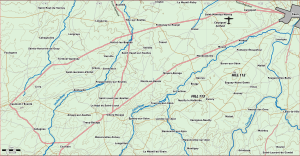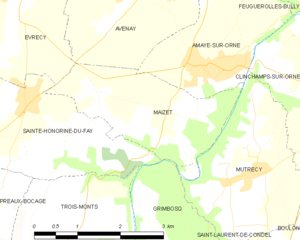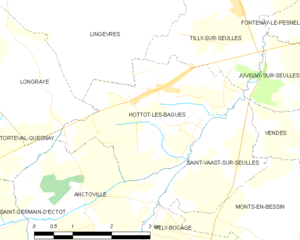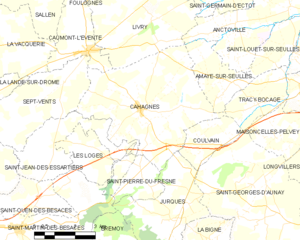Second Battle of the Odon facts for kids
Quick facts for kids Second Battle of the Odon |
|||||||
|---|---|---|---|---|---|---|---|
| Part of Battle for Caen | |||||||
 Vicinity of operations Greenline and Pomegranate |
|||||||
|
|||||||
| Belligerents | |||||||
| Commanders and leaders | |||||||
| General Miles Dempsey | General Heinrich Eberbach | ||||||
| Strength | |||||||
| 6 infantry divisions 5 tank/armoured brigades |
4 infantry divisions 3 Panzer divisions 1 heavy tank battalion |
||||||
| Casualties and losses | |||||||
| 3,000–3,500 | c. 2,000 | ||||||
The Second Battle of the Odon was a series of attacks by the British Second Army. These battles happened in July 1944 during World War II. They were part of the larger Battle of Normandy. The main goal was to stop German tanks from moving to other battle areas.
The British wanted to keep German tank divisions busy. This would help the US Army in their own attack, called Operation Cobra. The fighting in the Odon valley kept three German tank divisions stuck. This meant they could not join the fight east of the Orne River.
What Happened Before
The Big Plan: Operation Overlord
The town of Caen in Normandy was a key target for the British on D-Day, June 6, 1944. The British 3rd British Infantry Division landed on Sword Beach. Their mission was to capture Caen. This was a very important goal for the British.
The British Second Army was meant to take the city. Then, they would create a strong front line. This line would protect the US First Army on their left side. It would also provide space for airfields. Caen was also a good starting point for moving south. The British wanted to capture Falaise and then move towards Argentan.
The land near Caen was flat and dry. This was good for tank battles. The Allies had many more tanks than the Germans. So, a battle with lots of movement would help them. However, the 3rd Division could not attack Caen right away. They faced strong German defenses.
Operation Perch started on June 7. This was a pincer attack by two British corps. A pincer attack means attacking from two sides to surround the enemy. The goal was to surround Caen. But the German 21st Panzer Division stopped the British. Another German unit, the Panzer-Lehr Division, also held its ground.
From June 7 to 14, the British tried to get behind the German Panzer-Lehr Division. The 7th Armoured Division pushed through a gap. They reached Villers-Bocage. But they had to pull back from the town. By June 17, the Panzer-Lehr Division was pushed back. The British took Tilly-sur-Seulles. A big storm then hit the English Channel. This storm lasted three days. It slowed down the arrival of more Allied troops and supplies.
In Operation Epsom (the First Battle of the Odon), the British VIII Corps attacked. They moved south, west of Caen. They crossed the River Odon and the Orne River. Their goal was to capture high ground near Bretteville-sur-Laize. The Germans used all their tanks to stop this attack. This included two SS Panzer divisions. These divisions were new to Normandy. They were supposed to counter-attack the British and Americans.
Operation Jupiter (July 10–11) was another attack by VIII Corps. They wanted to capture Baron-sur-Odon, Fontaine-Étoupefour, and the rest of Hill 112. After this, they would take Éterville and Maltot. Tanks from the 4th Armoured Brigade helped the infantry. The first part of the attack went well. But the battle for Hill 112 lasted all day. The village of Maltot changed hands many times.
On July 14, General Bernard Montgomery sent a message to London. He said the real goal was to damage German troops. He wanted to hurt German tanks the most. All British actions in the east were to help the American forces in the west. This would also keep a strong British position in the east.
The US First Army had attacked on the west coast. But they made little progress in early July. The Germans were sending more infantry and tanks to the American front. So, it was important for the British to keep fighting in the east. This would stop more German troops from moving before the US Army attacked again on July 19.
Getting Ready for Battle
Britain Gets Ready
The British Second Army planned two smaller operations. These were to happen before Operation Goodwood on July 18. The goal was to stop the German Panzergruppe West from moving its tank divisions. The British had three tank divisions and seven tank brigades. They faced six German tank divisions and three heavy tank battalions. The British units were at full strength. But the German units had lost many tanks and soldiers.
The Germans had strong defenses. They used the land to their advantage. They also had many minefields and long-range anti-tank guns. They also had three Nebelwerfer (rocket launcher) brigades.
The British XII and XXX Corps planned holding attacks. These attacks were meant to improve their positions. They also wanted to trick the Germans. They wanted the Germans to think the main British attack would be west of the Orne River. But the real attack, Operation Goodwood, was being prepared east of the river.
On July 15, XII Corps was to attack from the Odon area. They wanted to create a safe starting line. This line would run from Bougy through Évrecy. The next day, XXX Corps would start operations near Noyers. They wanted to reach high ground near Villers-Bocage.
The Battle Plan
The XII Corps was made up of the 15th (Scottish) Infantry Division. It also had a brigade from the 53rd (Welsh) Infantry Division and the 34th Tank Brigade. The 43rd (Wessex) Infantry Division was also part of it. This corps would attack in Operation Greenline at 9:30 p.m. on July 15. They would use "Monty's Moonlight." This was a special technique using searchlight beams reflected from clouds to light up the ground.
The 53rd Division brigades would secure a starting line. Then the 43rd Division would attack towards Hill 112. They would create a path to the Orne River. This path would go through Bougy, Évrecy, and Maizet. This would allow them to advance further south.
Further west, XXX Corps would start Operation Pomegranate on July 16. The 49th (West Riding) Infantry Division would capture Vendes. The 59th (Staffordshire) Infantry Division would capture Noyers-Bocage and other villages. The 53rd (Welsh) Division would also attack. This would prepare the corps to advance towards high ground northeast of Villers Bocage.
Germany Prepares to Defend
On June 29, German Field Marshal Gerd von Rundstedt and Field Marshal Erwin Rommel met with Hitler. Hitler told them to keep defending Normandy. He also ordered them to plan a counter-attack.
When they returned, their commanders suggested pulling back from Caen. They wanted to move to a new line away from Allied naval guns. Hitler refused this idea. On July 2, Rundstedt was fired. Field Marshal Günther von Kluge replaced him. Two days later, another commander, Geyr, was also replaced.
On July 8, Hitler ordered that the front line in Normandy must be held. He believed another Allied invasion was coming in Pas de Calais. Kluge inspected the lines. He ordered that current positions must be held. He also said that a new counter-attack by seven tank divisions should be ready by August 1. This attack would aim to reach Luc-sur-Mer behind Caen. (Rommel thought this plan was not realistic. On July 16, he wrote to Hitler, saying the Normandy front would soon collapse. The next day, he was wounded by Allied aircraft.)
The Battle Begins
Operation Greenline: July 15-17
On the left side of the 15th (Scottish) Division, the 2nd Glasgow Highlanders attacked. They were supported by Churchill tanks. These tanks included Armoured Vehicle Royal Engineers (AVRE) and Churchill Crocodile flamethrower tanks. The Scottish soldiers moved southwest towards German defenses. As they came out of "dead ground" (areas hidden from enemy view), they faced heavy mortar fire. A smokescreen on Hill 112 also made it hard to see.
The Scottish soldiers crossed the starting line on time at 9:30 p.m. They captured SS soldiers after a flamethrower attack. They continued downhill, using "Monty's Moonlight." They were covered by fire from tanks on higher ground. Esquay-Notre-Dame was captured by 11:00 p.m. but not held. It was a "shell-trap" (a place where shells would easily hit and get trapped). Four tanks were lost, but many crews returned after dark. The troops dug in on the surrounding hills. The Germans thought this attack was aimed at Hill 112. So, they sent Tiger I tanks to stop an attack that never came.
Further west, the rest of the division captured Point 113. But they did not take Évrecy. This left the Glasgow Highlanders exposed. German counter-attacks focused on Esquay first. Then they hit the positions around le Bon Repos. Two Panzer IV tanks were destroyed by anti-tank guns. The Scottish soldiers were pushed back several times. But British artillery fire drove the Germans back. On July 18, the British tanks fought against dug-in Tigers. They lost four tanks on the ridge. The Highlanders held their positions for two days.
The 44th (Lowland) Brigade attacked Point 113, Gavrus, and Bougy. The 227th Brigade was to capture Esquay and then attack Évrecy. The main 44th Brigade attack began with the 6th King's Own Scottish Borderers (KOSB) on Point 113. "Monty's Moonlight" helped the night advance. The 6th KOSB moved directly into German defenses. By morning, the Scottish soldiers were dug in on the hill.
At 5:30 a.m. on July 16, the 8th Royal Scots (8th RS) advanced towards Gavrus. Tanks attacked from the side of the hill. This protected them from Germans in Évrecy. By 7:45 a.m., the 8th RS had taken the village and 70 prisoners. A similar attack on Bougy took 100 more prisoners. During the day, the Germans counter-attacked several times. But British artillery stopped them. In the afternoon, the Germans attacked twice with Tiger and Panther tanks. They were with infantry. Mortar fire was constant. But no ground was lost. Both sides suffered many casualties.
The 6th Royal Scots Fusiliers (6th RSF) moved to Gavrus. The 8th RS formed up at Bougy. On the left, the situation got worse. The 227th Brigade failed to take Évrecy. By dawn on July 16, the 15th (Scottish) Division had captured Bougy and Gavrus. They also dug in around Esquay and the west end of Point 113. On July 17, the front line became quieter. But the 44th Brigade was exposed. They faced heavy artillery fire. The 6th KOSB pushed forward to the Bougy–Évrecy road. An attack by the 59th (Staffordshire) Division made very slow progress. Four more German counter-attacks were stopped. During the night, the brigade was replaced by the 71st Brigade. The 9th SS Panzer Division was brought in. By the end of the day, they had restored the front line, except at Hill 113.
The 158th Brigade of the 53rd (Welsh) Division was to attack on July 16. But the attack was delayed. Minefields around Baron had not been cleared. Several tanks were disabled by mines. The attack was then cancelled due to fog. It finally began late on July 17. Attacking Évrecy meant a long advance downhill. The attack was not well prepared. The infantry was too tired to keep up with the tanks. About 150 prisoners were taken. But mortar fire forced the infantry back. The 53rd (Welsh) Division captured Cahier. They stopped several big counter-attacks. More attacks by XII Corps gained no ground. On the evening of July 17, the British on Point 113 pulled back. This ended the operation.
Operation Pomegranate: July 16-17
On July 16, XXX Corps started Operation Pomegranate. The 50th (Northumbrian) Division had held ground north of Hottot. They had frequent patrols and raids. These caused several German counter-attacks. The 56th Independent Brigade attacked Hottot on July 8. They captured their target. But a German counter-attack pushed them back. On July 11, the 231st Brigade attacked Hottot again. They reached the northern edge of the village.
During the attack on July 18, the 50th Division captured Hottot for the last time. This was helped by German withdrawals due to Operation Goodwood and Operation Cobra. Taking Hottot meant the 50th Division was ready to capture Villers Bocage. On the right side of the 50th Division, the 56th Independent Infantry Brigade faced the 2nd Panzer Division. This German unit kept up constant attacks. By July 20, the British realized the enemy had pulled back from the La Chapelle area. A patrol went forward and dug in. Then a company advanced and dug in on the southern edge of the woods.
In the center of XXX Corps, the 49th (West Riding) Division attacked. The 146th Brigade attacked la Barbée Farm. They reached the farm quickly. At 5:00 p.m., the Germans counter-attacked. They surrounded the farm on three sides. The Hallamshire Battalion attacked Vendes directly. But machine-gun fire stopped them quickly. An attempt to attack from the side also failed. The British battalions pulled back at 5:00 p.m. The next day, they found out the Germans had pulled back from Vendes and the farms.
In the 59th (Staffordshire) Division area, the attack began at 5:30 a.m. The 5th East Lancashires fought their way to the first objective. They captured part of the village by 8:00 a.m. But at 2:30 p.m., German infantry and tanks counter-attacked. They forced the British back to their starting line. The 1/6th South Staffords captured Brettevillette. Many troops got lost in the thick mist. The British found many mines in the area. The battalion pushed on and reached Queudeville by 8:45 a.m. Most of their supporting tanks had been destroyed in a British minefield.
The 5th South Staffords took orchards west of Grainville sur Odon. They captured Les Nouillons by noon. This meant the 177th Brigade was on its first targets. At 1:30 p.m., special "flail tanks" began clearing a German minefield. Phase II was delayed by casualties. But at 5:30 p.m., the 2/6th South Staffords attacked Noyers. The 6th North Staffords attacked Haut des Forges. The 2/6th South Staffords captured part of Noyers. But they were forced back. The 6th North Staffords took Haut des Forges. The 59th Division captured 369 prisoners.
At dawn on July 17, the 2/6th South Staffords attacked Noyers. They got close to the railway station. But they were forced to take cover. They pulled back at 1:30 p.m. to reorganize. In the afternoon, the 5th South Staffordshires attacked Noyers from the northeast. But they were held up. The 1/6th South Staffords advanced towards Bordel. They faced strong resistance. When night fell, the British pulled back slightly from Noyers.
The next day, the 177th Brigade attacked Noyers at 10:00 a.m. They had tanks and flamethrower tanks. But they could not advance far against strong German resistance. Five more tanks were lost. Another attack in the afternoon failed. The British pulled back after dark. On the right, the 1/7th Royal Warwicks reached Ferme de Guiberon by nightfall. The 49th Division reported that Germans had pulled back from their front. In the center, the 7th South Staffords took Bordel. They faced few German troops, but much artillery fire.
The 197th Brigade was replaced by the 176th Brigade overnight. The 7th Royal Norfolks took over positions that had been captured. The British infantry had captured high ground south of Brettevillette. They took 300 prisoners on the first day. The next day, the advance continued. There was much fighting on the edge of Noyers-Bocage. The Germans claimed to have recaptured Noyers-Bocage. But XXX Corps had been held up on the outskirts. They had captured the high ground outside the village and the railway station. The 49th Division captured Vendes. The 59th Division took Haut des Forges. They entered Noyers but were pushed back. The 50th Division captured Hottot-les-Bagues. This village had been fought over for more than a month. They took 300 prisoners.
After the Fighting
Who Was Hurt?
British casualties in these operations were about 3,000 to 3,500 soldiers. The German defenders lost about 2,000 soldiers. The 107th RAC lost 46 men. The 147th RAC lost six tanks in one area and four in another. From July 15 to 18, the 147th RAC had 47 casualties. When the 153rd RAC pulled back, 96 tank crew members were casualties. Twelve tanks were destroyed, and many were damaged.
In three days, the 34th Tank Brigade lost 30 officers and 156 men. They still had 97 tanks working. The 15th (Scottish) Division lost 1,000 men. The 59th Division lost 1,250 men. They took 575 prisoners from two German infantry divisions. These divisions were supported by parts of two German tank divisions. Until July 16, the 276th German Division lost 1,000 men. By the end of the month, they had lost 388 killed, 1,851 wounded, and 461 missing. The 277th German Division lost 1,000 men from July 13 to 16. By the end of the month, they had lost 312 killed, 1,327 wounded, and 1,161 missing.
What Happened Next
Operation Goodwood: July 18-20
After these first attacks, Operation Goodwood took place from July 18–20. The British VIII Corps attacked. They aimed to capture the Bourguébus Ridge. They also wanted to destroy as many German tanks as possible. On July 18, I Corps advanced to secure villages and the eastern side of VIII Corps. On the western side of VIII Corps, the II Canadian Corps launched Operation Atlantic. They wanted to capture the rest of Caen south of the Orne River. When Operation Goodwood ended on July 20, the British had broken through German defenses. They had advanced 7 miles (11 km) towards the ridge.
Operation Express: July 22
The village of Maltot had been taken by the Germans. On July 22, the British planned to attack Maltot from the northeast. During Operation Jupiter, the attack had crossed open ground. This ground was easily seen from Hill 112. Operation Express would start from Louvigny. The 5th Wiltshire Battalion and tanks would capture the village. The 4th Wiltshire and more tanks would attack woods and orchards.
The attack began at 5:30 p.m. The 5th Wilts advanced behind smoke and artillery fire. The German defenders were surprised. As the British moved through the village, some Germans fought back. Hand-to-hand fighting happened. German tanks began a counter-attack as Maltot was entered. They destroyed several British tanks. A British air controller saw the German tanks. He called in Typhoon fighter-bombers. These planes forced the German tanks back to Hill 112.
On the other side of the road, the 4th Wilts and their tanks advanced. They moved through woods and farms. The infantry went first, with tanks behind them. When they saw that the 4th Wilts were delayed, Churchill and Churchill Crocodile tanks advanced. They attacked the defenders with fire. As the advance moved into the woods, small groups of British and German soldiers fought among the trees. The German defenders were defeated in about two hours. Some Germans held out as dark fell. Most surviving defenders pulled back to Château Maltot. This castle was then surrounded.
From 9:30 to 10:00 p.m., both British battalions reached their final targets. The tanks pulled back. They had lost eight vehicles. Just after dawn, the remaining Germans in the castle gave up. They had lost hope of being rescued. By the end of Operation Express, the German 10th SS Panzer Division had lost many men. They could only counter-attack in the most important places. By dawn, the British saw the dead from Operation Jupiter. They also faced fire from German tanks on Hill 112. They had taken over 400 prisoners. The 43rd (Wessex) Division was pulled out. The 53rd (Welsh) Division took over the ground. Hill 112 was captured easily on August 4. This happened as the Germans were busy fighting Operation Cobra and Operation Bluecoat further west.
Fighting in the Odon Valley: July 18 - August 2
The Glasgow Highlanders were replaced by the 1/5th Battalion, Welch Regiment on July 17. From July 18, the 34th Tank Brigade helped the 53rd (Welsh) Division. This division extended its line to the Orne at Maltot. The 153rd RAC returned to the line after eight days of rest. On July 21, at 4:00 p.m., the 10th SS Panzer Division attacked the battalion. One company was overrun. The Germans pushed back the Welsh front. The survivors pulled back. Several British tanks were lost. They were out-ranged by six Tiger tanks from Hill 112. Two days later, the 4th Welch Battalion raided the captured positions. They were helped by Churchill Crocodiles. They caused many casualties to the Germans before pulling back.
The 107th RAC had no losses. They even got back a tank lost in the previous attack. A smoke screen helped the raid happen in daylight. This prevented many casualties. The 49th Division occupied Vendes on July 19. But patrols found Noyers still occupied. An attack was cancelled. On August 2, the 107th RAC raided Esquay again. The area near Bougy was raided by troops. The area near Maltot was raided by the 153rd RAC. Until August 5, 247 tank crew members were casualties. 47 tanks were destroyed. About half were written off, and the rest were repaired.
In the 49th Division area, the 146th Brigade advanced again on July 19. German infantry and two Tiger tanks had reoccupied two farms. But British artillery fire forced them out. Two battalions moved forward behind engineers. The engineers cleared many mines on the road to Château Juvigny. This had been a German headquarters. At the end of July, the 8th Armoured Brigade moved to support the 43rd (Wessex) Division. The 13th/18th Hussars supported the 50th (Northumbrian) Division. Their goal was the Butte du Mont à Vent ridge.
The 43rd (Wessex) Division attack began on July 30. They moved into the "bocage" (a type of countryside with small fields and hedges). This area was full of mines and booby traps. The Sherwood Rangers Yeomanry helped the 130th Infantry Brigade attack Cahagnes. On the left, the 13th/18th Hussars took Saint-Germain-d'Ectot and Orbois. The 12th King's Royal Rifle Corps advanced. They dug in to protect the side of the 43rd Division. The 50th Division captured Amayé-sur-Seulles. The Sherwood Rangers Yeomanry advanced at night. They had infantry on their tanks. They captured Jurques. During the day, La Bigne and Loisonniers were captured. They overcame strong German resistance. The British advance then stopped near Mont Pinçon. This hill overlooked the area.






